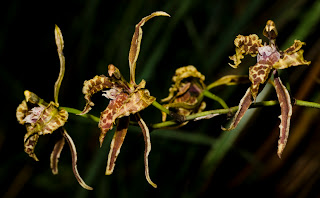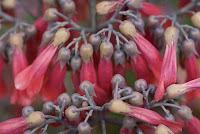 In Norse mythology Valhalla is the hall in which Odin entertained the slain heroes of battle for eternity. One night was long enough for me! The only people that appear to stay in this pink monstrosity are groups waiting for transfer to Cotopaxi or preparing by climbing Illiniza Norte. Luckily we only needed to spend one night there before making the transfer ourselves. Our fellow guests in Valhalla were Mike and Jim, my climbing partners for Cotopaxi. In both cases they had significant climbing experience in the UK and had just come back from an acclimatisation climb of Illiniza Norte. Even Mike and Jim seemed nervous on the morning that we left for the refuge on Cotopaxi. The previous night's victims returned to Valhalla at around eleven looking shell shocked and physically exhausted. Stories of snow storms and altitude sickness were dismissed with optimism as we sat down to a large plate of pasta and beef.
In Norse mythology Valhalla is the hall in which Odin entertained the slain heroes of battle for eternity. One night was long enough for me! The only people that appear to stay in this pink monstrosity are groups waiting for transfer to Cotopaxi or preparing by climbing Illiniza Norte. Luckily we only needed to spend one night there before making the transfer ourselves. Our fellow guests in Valhalla were Mike and Jim, my climbing partners for Cotopaxi. In both cases they had significant climbing experience in the UK and had just come back from an acclimatisation climb of Illiniza Norte. Even Mike and Jim seemed nervous on the morning that we left for the refuge on Cotopaxi. The previous night's victims returned to Valhalla at around eleven looking shell shocked and physically exhausted. Stories of snow storms and altitude sickness were dismissed with optimism as we sat down to a large plate of pasta and beef.The trip into the Cotopaxi National Park gave us a first taste of the high altitude environment that is home to several of Ecuador's high peaks. As we reached the high altitude plain that sits at the base of Cotopaxi it immediately reminded me of two of my favourite landscapes from our previous travels: the Deosai plains or Pakistan and the Morai plains of Ladakh. The sparse, low growing, alpine plants cut through by the flood plain of a seasonal river, separated Cotopaxi (5897m) from Ruminahui (4722m) and Sincholagua (4900m). As we began the climb from the flood plain up to the car park below the refuge I could tell that the altitude was beginning to affect Sarah and the steep climb up from the car park to the refuge was a stark reminder of the challenges of climbing the highest active volcano in the world. The eroded sand, six inches deep and a vivid ochre, sapped our energy with every step and over the 300m of ascent, reinforced to Sarah that the altitude would prove too much of a challenge.
After a brief walk on the glacier with our guides and a run through of the various techniques that we would need, we returned to the refuge for some food and fluids to fuel the climb. We were in bed by 7.15pm for a fitful few hours of sleep before our alarm call at midnight. I felt strong as we gathered our kit together for the climb. As we sat down for breakfast all three of us seemed to have the mixed emotions of excitement and trepidation as we heard the wind whistling through every gap in the refuge and saw the ice formed on the windows. By 1am we were on the mountain. At 4800m every step is artificially slow and deliberate to avoid oxygen deficit and to make the overall pace of the climb uniform. Within 15 minutes we were donning our crampons and roping up to our guides. As we crossed the first tongues of the glacier the lights of Quito were competing with the stars for my attention. Each step pierced the icy crust that only hours before was ankle deep snow. The visual tranquility of the mountain was firmly at odds with the whistling wind as waves of cloud passed above and below us.
As we approached the top of the first section the glacier began to get steeper moving from 30-45% gradient. Our easy, overstepping traverses turned into a series of vertical alternating front point kicks with deep plants of the ice axe for stability. Thirty minutes turned into an hour of steady, hypnotic climbing. My headtorch was focused on the feet of Robinson, my guide. Each footstep repeating, each plant of the ice axe providing the stability and reassurance needed to ignore the exposure. After and hour and half we stopped for food and fluid before tackling a particularly steep section of ice that led round a rock arrete.
Climbing in the dark is more mentally than physically challenging. Your whole world is shrunk down to the one metre diameter of your head torch. Your only points of reference are the other climbers above and below you, but it is impossible to tell how far way they are. As you embark on each section, you may know that it is 200 vertical metres but you can never see the top. The climb almost takes you into a zen like state. All I could think about as the wind bit into my cheeks an nose was the specific action of swinging my right foot over my left, planting all ten spikes of my crampon and shifting my weight from one foot to the other. This was repeated every ten seconds, hour after hour. The combination of the altitude, the wind and cold made conversation sparse. An hour would pass without any words being said. Time seemed to shrink in the enormity of the mountain, the repition of movement.
As we approached the ridge at 5400m we had been climbing for almost three hours and the conditions had deteriorated further. Robinson, my guide, told me that the we would have another three to four hours of climbing to summit. It seemed like we had been climbing for five or six hours but in reality it was only three. Sunrise was still several hours off and the temperature was dropping. My watch recorded -15 degrees without wind chill and my carefully managed water source had frozen. Everything rational was telling me to turn around but all I could think was that the descent would be easier and two hours more of purgatory would be justly rewarded by the summit.
"Vamos" was my only word. Let's go. For the next hour the ground conditions got steadily worse. The crisp crust of ice had turned into 6 inches of soft snow. On the steeper sections each step regressed by a foot. As the altitude increased this constant slipping weighed on my mind and taxed my lungs; my breathing became deeper and more frequent. The frozen material covering my mouth and nose began to inhibit each lung full of air. My fingers on the hand carrying the ice axe were beginning to lose sensation and I could feel myself entering energy deficit. With 300 vertical metres to go to the summit and having crossed a dangerous snow bridge spanning a crevasse I asked Robinson to stop so I could get some food. Thankfully my bottle of Gatorade was still liquid. Unable to stomach sweet food I opened a packet of savoury crackers with my mouth as I couldn't feel my index finger and thumb on my right hand. The dry crackers soaked up the remaining saliva I had, so I went to take a drink of Gatorade only to find that the plastic safety cover was still on. A schoolboy error that led to five minutes of fiddling with my numb fingers to access the sorely needed liquid.
The next hour of the climb seemed like a neverending battle with the wind and soft snow. As we approached the final steep incline to the summit Robinson turned to ask me if I wanted to continue. With only an hour of climbing separating me from the summit I couldn't justify to myself turning around. I asked if he thought I could make it and he affirmed with a silent but deliberate nod. We ploughed on through the steep snow, digging steps with our crampons whilst anchoring ourselves to the slope with our axes. As we approached 5800m I saw Jim descending towards us covered head to toe in wind blown ice and snow. I looked into his eyes and all I could see were the white frozen hairs of his eyelashes as he blinked. He had had to turn back 50m from the summit due to a metre and a half of accumulated snow creating an avalanche risk that the guides would not ignore. That was all the encouragement I needed to turn around. I didn't feel defeated, just elated at the prospect of descent. I had accomplished everything that I had wanted to. I had experienced the world of high altitude mountaineering in the most extraordinary circumstances and struggled through. I had won the constant battle with my rational mind and yet made the right decision when it counted.
Exhausted, tired and slightly elated I traipsed into the refuge and slumped down by Sarah. I had given everything and gained a heartfelt respect for the privileged few that excel in those conditions and worse. I hope that I will don crampons again, but will need the soothing sun of the Galapagos to reflect on my experience and take stock of what was a unique, crushing and yet self affirming experience.










-3.jpg)
-5.jpg)

